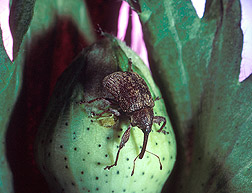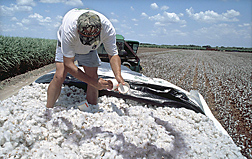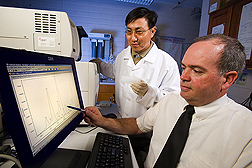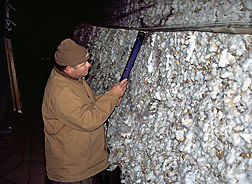Where’d That Boll Weevil Come From?
DNA-marker technology helps
keep tabs on legendary insect pest.
|
|
The devastation wrought by the boll weevil, Anthonomus grandis, on the U.S. cotton industry during most of the 20th century is the stuff of social, economic, and agricultural legend.
Though evicted from more than 12 million acres of southern farmland by eradication efforts started in the 1970s, the pest is still found in portions of the mid-South and South Texas.
“In Texas and surrounding states, it’s common for a zone that’s far advanced in boll weevil eradication to share borders with zones still harboring substantial weevil populations,” says entomologist Tom Sappington, in ARS’s Corn Insects and Crop Genetics Research Unit at Ames, Iowa. “So the threat of reintroduction remains a constant concern.”
Bill Grefenstette, national coordinator for boll weevil eradication for USDA’s Animal and Plant Health Inspection Service, says that these remaining areas should be free of the pest within 4 years. But Sappington knows that until that time—and well past it—vigilance will be a key weapon against the weevil.
Using modern DNA-marker technology, Sappington and colleagues are keeping close tabs on this nemesis of cotton farmers. They are combining conventional microsatellite analysis with population-assignment techniques to pinpoint the migratory patterns and origins of dispersing boll weevils.
They Get Around
“Identifying recent boll weevil migrants in local populations and knowing where they came from can greatly enhance
insect-pest management,” says Sappington. “It results in better strategies for monitoring, and responding to, pest introductions. Knowing the source of a reintroduction into an eradication zone helps us determine appropriate actions to stem the flow.”
Sappington has studied the boll weevil’s movements for more than 8 years. While at ARS’s Kika de la Garza Agricultural Research Center in Weslaco, Texas—where weevils were marked with enamel paint or fluorescent powder and then recaptured—he collected valuable data about the insect’s ability to spread via cotton-transport and ginning operations.
“We did some important genetic studies there,” he says, “but it wasn’t easy to use microsatellites, because we didn’t have the right equipment.” Upon arriving in Ames in 2003, Sappington used his new lab’s genetic-studies tools to expand the research.
Microsatellites are repetitive, short sequences of DNA. Also called “short tandem repeats,” they provide scientists with a way of locating genes.
“They’re seeing extensive use in the entomological community, especially in tracing inheritance patterns,” says Sappington. “But there are relatively few instances of microsatellites being applied to characterize movement of insects. We’ve found that they’re very useful when applied in statistical population-assignment tests.”
These population tests have helped scientists trace invasion routes of other insect pests, including gypsy moths, Mediterranean fruit flies, and western corn rootworm. “Linking information from microsatellite analysis to animal movement is a relatively new and powerful approach that’s being widely used in conservation genetics and fisheries studies,” says Sappington. “But it’s an approach that’s been underused by entomologists.”
|
|
South of the Border
Sappington’s latest study, conducted with ARS molecular biologist Kyung Seok Kim from his Ames unit, was the result of a request from Pedro Cano-Ríos, a scientist at Mexico’s National Institute for Forestry, Agronomy, and Animal Research.
Cano-Ríos caught several boll weevils in pheromone traps in 2004 near Tlahualilo, Durango, next to a Mexican eradication zone. Weevils had not been reported in that part of Mexico for about 10 years. “Our goal was to determine whether a small boll weevil population had been there all along or the captured weevils had migrated in from somewhere else,” says Sappington.
To identify the weevils’ most likely origin, Sappington, Kim, and Cano-Ríos compared microsatellites in weevils caught in Tlahualilo to microsatellites in three other populations in northern Mexico and from one in southern Texas.
The microsatellites revealed that boll weevil migrants from the state’s still-infested Lower Rio Grande Valley were greatly hindering final eradication of the pest in the Lower Coastal Bend, near Kingsville. The researchers also found strong genetic evidence of boll weevil migration from the Tampico, Mexico, area to the valley.
The results from Tlahualilo suggested that, while some of the boll weevils caught there in 2004 were immigrants, the bulk were residents whose relatively low numbers probably increased that year because of higher-than-usual rainfall.
“Both studies demonstrate that microsatellite markers and population assignment techniques are practical tools for determining the most likely origins of boll weevils reintroduced to eradication zones in the United States and Mexico,” says Sappington. “These techniques also hold promise for replacing conventional mark-and-recapture studies of insect dispersal.”
Mark and Recapture
Sappington had made effective use of the mark-and-recapture technique while in Texas. Working with agricultural engineers Alan Brashears and Roy Baker of ARS’s Cropping Systems Research Laboratory at Lubbock and colleagues at Texas A&M University and the Texas Agricultural Experiment Station, he used it to study boll weevils’ dispersal from harvested cotton and their survival through the cotton ginning process.
Early in the 20th century, cotton gins contributed to the spread of boll weevils throughout the United States. “That’s not the case today,” says Sappington. “Today’s gin stands use more closely spaced saws that operate at higher speeds. Our studies show that the probability of boll weevils entering the gin stand and surviving intact in ginned lint is very close to zero.”
In fact, Cano-Ríos’s original concern was that the boll weevils had migrated to Tlahualilo in cottonseed imported as cattle feed from the United States and other parts of Mexico.
“Fortunately, our previous ginning research showed that it is virtually impossible for weevils to survive the gin and be transported alive in cottonseed,” says Sappington. “Mexican authorities used that research to decide the seed did not require fumigation, saving them and U.S. exporters a lot of money—and the environment a lot of needless insecticide input.”—By Luis Pons, formerly with ARS.
This research is part of Crop Protection and Quarantine, an ARS national program (#304) described on the World Wide Web at www.nps.ars.usda.gov.
Thomas Sappington is in the USDA-ARS Corn Insects and Crop Genetics Research Unit, Genetics Building, Iowa State University, Ames, IA 50011; phone (515) 294-9759, fax (515) 294-2265.
"Where’d That Boll Weevil Come From?" was published in the August 2007 issue of Agricultural Research magazine.










